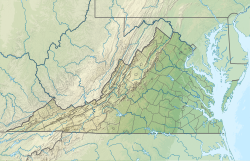| Bull Run Formation | |
|---|---|
| Stratigraphic range: Norian ~222–210 Ma PreꞒ Ꞓ O S D C P T J K Pg N | |
| Type | Geological formation |
| Unit of | Chatham Group |
| Sub-units | Ball's Bluff & Groveton Members |
| Lithology | |
| Primary | Mudstone |
| Other | Shale, siltstone |
| Location | |
| Coordinates | 38°54′N 77°24′W / 38.9°N 77.4°W / 38.9; -77.4 |
| Approximate paleocoordinates | 13°18′N 21°48′W / 13.3°N 21.8°W / 13.3; -21.8 |
| Region | Maryland, Virginia |
| Country | |
| Extent | Culpeper Basin |
  | |
The Bull Run Formation is a Late Triassic (Norian) stratigraphic unit in the eastern United States. Fossil fish bones and scales have been found in outcrops of the formation's Groveton Member in Manassas National Battlefield Park. Indeterminate fossil ornithischian tracks have been reported from the formation.
The Bull Run Formation was once considered part of the Culpeper Group of the Newark Supergroup, but the United States Geological Survey no longer formally recognizes this formation (it is abandoned).
Fossil content
The following fossils were reported from the formation:
- Ichnofossils
- Agrestipus hottoni
- Eubrontes cursorius
- Kayentapus minor
- Grallator (Eubrontes)
- Anomoepus sp.
- Diplurus sp.
See also
References
- ^ Bull Run Formation at Fossilworks.org
- Hunt et al., 2006, p.64
- Weishampel et al., 2004, pp.517-607
- Bull Run, National Geologic Map Database, Geolex — Unit Summary, USGS.
Bibliography
- Hunt, ReBecca K., Vincent L. Santucci and Jason Kenworthy. 2006. "A preliminary inventory of fossil fish from National Park Service units." in S.G. Lucas, J.A. Spielmann, P.M. Hester, J.P. Kenworthy, and V.L. Santucci (ed.s), Fossils from Federal Lands. New Mexico Museum of Natural History and Science Bulletin 34, pp. 63–69
- R. E. Weems. 2006. The manus print of Kayentapus minor: its bearing on the biomechanics and ichnotaxonomy of early Mesozoic saurischian dinosaurs. In J. D. Harris, S. G. Lucas, J. A. Spielmann, M. G. Lockley, A. R. C. Milner, & J. I. Kirkland (eds.), The Triassic-Jurassic Terrestrial Transition. New Mexico Museum of Natural History and Science Bulletin 37:369-378
- Weishampel, David B.; Dodson, Peter; Osmólska, Halszka (2004), The Dinosauria, 2nd edition, Berkeley: University of California Press, pp. 1–880, ISBN 0-520-24209-2, retrieved 2019-02-21
- R. E. Weems and P. G. Kimmel. 1993. Upper Triassic reptile footprints and a coelacanth fish scale from the Culpeper Basin, Virginia. Proceedings of the Biological Society of Washington 16(2):390-401
- J. R. Smith. 1982. Dinosaurs in Virginia—evidence of two new genera. Lapidary Journal 36(6):1110-1111
- R. Weems. 1979. A large parasuchian (phytosaur) from the Upper Triassic portion of the Culpeper Basin of Virginia (USA). Proceedings from the Biological Society of Washington 92(4):682-688
This article about a specific stratigraphic formation in Maryland is a stub. You can help Misplaced Pages by expanding it. |
This article about a specific stratigraphic formation in Virginia is a stub. You can help Misplaced Pages by expanding it. |
- Geologic formations of Maryland
- Geologic formations of Virginia
- Triassic System of North America
- Triassic geology of Virginia
- Norian Stage
- Mudstone formations
- Shale formations
- Siltstone formations
- Lacustrine deposits
- Ichnofossiliferous formations
- Paleontology in Virginia
- Southern United States geologic formation stubs
- Maryland geography stubs
- Virginia geologic formation stubs